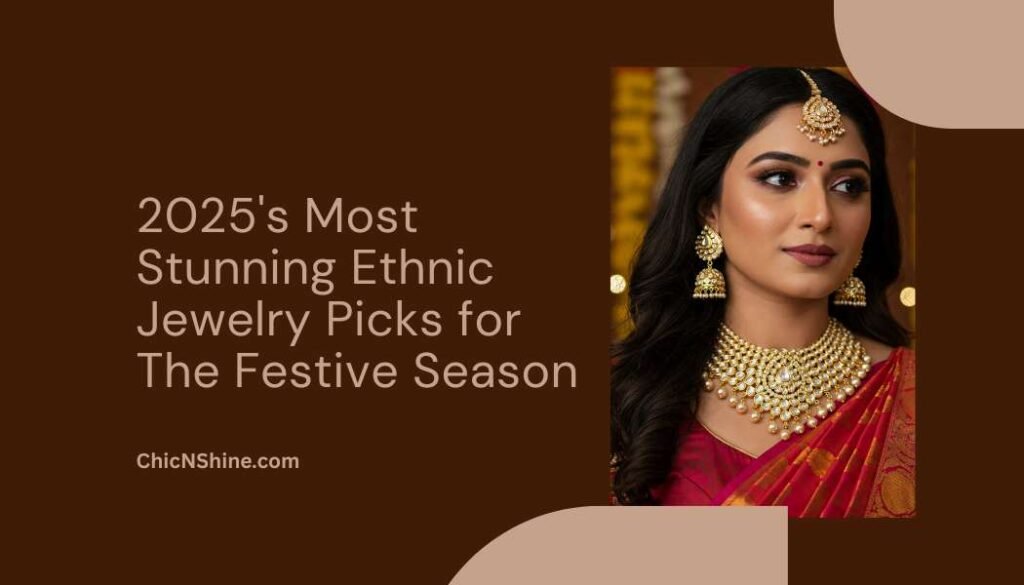The first time I wore my grandmother’s antique gold jhumkas to a Diwali celebration, I had no idea they would spark such admiration and heartfelt conversations. Those heirloom pieces weren’t just jewellery—they were a bridge to my roots and a tribute to generations past. That festive evening made me realize that ethnic jewellery in the festive season is far more than an accessory; it’s a celebration of culture, craftsmanship, and identity. It’s the final, radiant touch that elevates any traditional outfit into something truly unforgettable.
As someone who has spent years collecting and curating ethnic jewellery pieces—from traditional family heirlooms to contemporary designer creations—I’ve developed a deep appreciation for how these adornments can elevate festive celebrations. With the upcoming festive season approaching, I’m excited to share my carefully selected recommendations for the most stunning ethnic jewellery that honours tradition while embracing modern sensibilities.
Expert Quote:
“Oxidised silver works best for daytime events, while polki stones catch reception lighting beautifully,” says Priya , Jaipur-based jewelry designer.
The Enduring Allure of Ethnic Jewelry
The term “ethnic jewellery” encompasses a vast world of traditional adornments from various cultures, each with its unique craftsmanship, symbolism, and aesthetic appeal. What makes these pieces particularly special during festive occasions is their ability to:
- Connect us to our cultural heritage and family traditions.
- Showcase exquisite craftsmanship that often employs techniques passed down through generations
- Make a bold, distinctive statement that elevates even simple festive attire
- Serve as meaningful investments that can become tomorrow’s heirlooms
In my collection, I treasure pieces from different cultural traditions—Indian Kundan sets that catch the light during Diwali celebrations, Moroccan filigree that adds drama to Eid ensembles, and tribal silver that grounds me during harvest festivals. The festive season offers the perfect opportunity to embrace these cultural treasures and incorporate them into celebratory looks.
1 – Statement Necklaces: The Centerpiece of Festive Jewelry
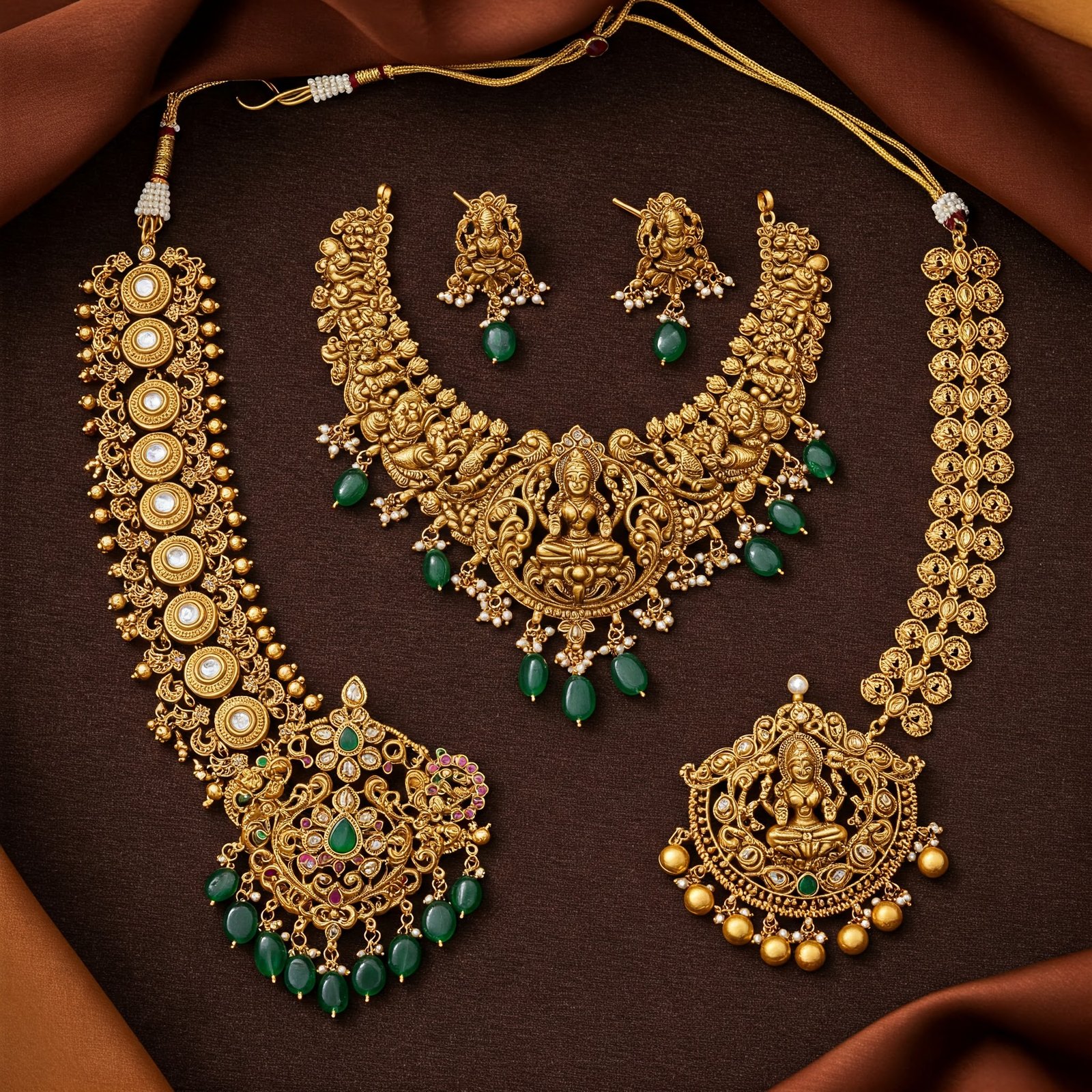
1. Traditional Kundan and Polki Sets
Nothing captures the essence of royal Indian heritage quite like Kundan and Polki jewellery. These traditional techniques involve setting uncut diamonds (Polki) or glass (Kundan) in gold, often combined with vibrant enamelling (meenakari) work.
My first significant ethnic jewellery investment was a Kundan choker with emerald and ruby accents. Its intricate craftsmanship meant it required a substantial portion of my savings, but years later, it remains my go-to piece for significant family celebrations. The weight and presence of a quality Kundan necklace transform even a simple silk saree into a regal ensemble.
When shopping for Kundan pieces, I’ve learned to:
- Examine the back of the piece for finishing quality (a well-crafted Kundan set should be beautiful from every angle)
- Check the security of the stone settings by gently running a fingernail across them
- Look for evenness in the meenakari work, which indicates skilled craftsmanship
- Consider the weight distribution, as well-designed pieces sit comfortably despite their substantial size
My tip: For those new to traditional jewellery, a choker-style Kundan necklace offers versatility—it works beautifully with both high-necked blouses and deeper necklines, making it a practical first investment.
2. Temple Jewelry
Rooted in South Indian temple architecture and divine symbolism, temple jewellery beautifully blends spirituality with intricate craftsmanship. These gold-toned pieces often feature motifs like goddesses, peacocks, mangoes, and coins, and their rich, three-dimensional detailing makes them shimmer with every movement. As part of my ethnic jewellery festive season collection, I added a temple jewellery necklace set after watching a classical dance performance—the dancer’s ornate adornments seemed to narrate a sacred story. Since then, my Lakshmi haar has become a staple piece for my Navratri celebrations, embodying both tradition and timeless elegance.
What makes temple jewellery particularly special for festive occasions:
- The religious motifs connect the wearer to cultural and spiritual traditions
- The substantial gold work creates a warm glow against any complexion
- The distinctive style stands out even in settings where everyone is dressed in their finest
- The designs remain remarkably timeless, never looking dated or trendy
My personal tip: Temple jewellery pairs beautifully with Kanjeevaram silk sarees in traditional colours. However, I’ve also worn my temple choker with a contemporary black and gold ensemble for a stunning fusion look.
3. Contemporary Fusion Statement Pieces
Contemporary fusion necklaces offer the perfect middle ground for those who appreciate ethnic influences but prefer more versatile styling options. These pieces typically incorporate traditional elements—like jadau work, art, or tribal motifs—into more wearable, modern designs.
My most-worn festive season piece is actually a gold-plated silver necklace that combines traditional filigree techniques with a contemporary silhouette. It’s substantial enough for special occasions but lightweight enough for comfortable all-day wear during festivals.
What to look for in fusion statement necklaces:
- Traditional craftsmanship techniques applied to updated designs
- Versatile length and weight that works with various necklines
- Mixed metals that complement different accessories
- Pieces that make a statement while remaining comfortable
My tip: Fusion pieces work beautifully for multicultural celebrations or when you’re attending multiple events requiring different dress codes. I often wear my contemporary pendant set with both Western evening wear and traditional lehengas.
2 – Earrings That Frame the Face
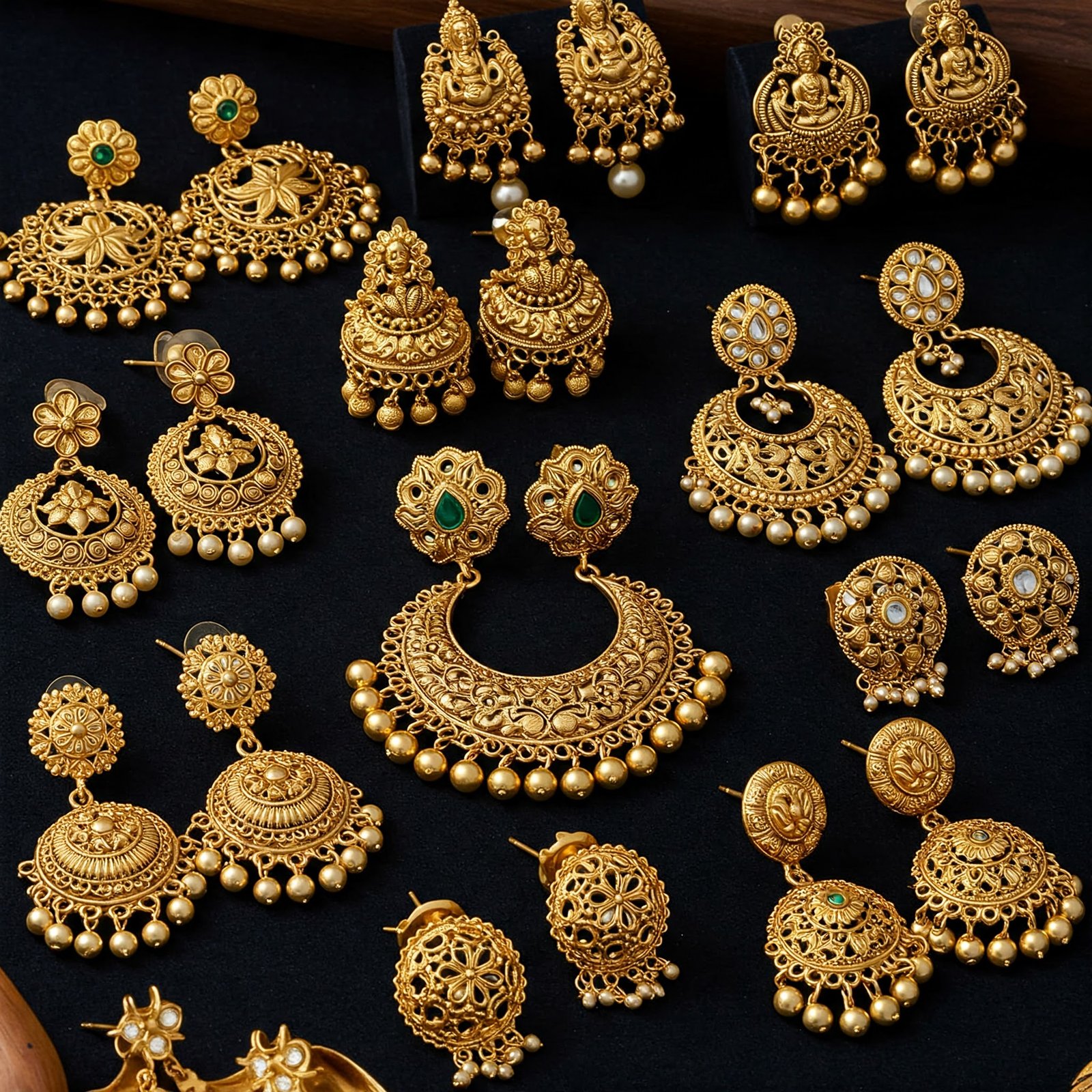
1. Jhumkas and Chandbalis: Timeless Classics
In my experience, no ethnic jewellery collection is complete without at least one pair of statement earrings. Traditional jhumkas (bell-shaped earrings) and chandbalis (crescent moon designs) instantly elevate any festive look by beautifully framing the face.
My collection began with a pair of silver jhumkas inherited from my mother. Over the years, I’ve added various styles—from elaborate gold chandbalis for wedding seasons to everyday silver-toned pieces for smaller celebrations.
What makes these earring styles particularly flattering:
- The movement of dangling elements catches light and draws attention to the face
- The classic silhouettes complement various hairstyles, from traditional updos to flowing locks
- The dimensional design creates beautiful shadows and highlights when photographed
- The distinctive shapes are immediately recognizable as cultural adornments
My tip: If you’re wearing heavy jhumkas for an extended celebration, look for styles with screw-backs or supportive ear clips. I also recommend carrying transparent ear supports that can be added if you feel discomfort during longer events.
2. Statement Studs and Tops
For those who find chandeliers and jhumkas too heavy or who prefer a more subtle look, statement studs offer a wonderful alternative. Modern designers are creating spectacular ethnic stud earrings using traditional techniques like paci and jadau in more compact designs.
I discovered the versatility of statement studs when attending a family wedding with an elaborately embroidered high-necked blouse. My usual dangling earrings competed with the neckline, but a pair of oversized gold filigree studs provided the perfect solution—adding sparkle without overwhelming.
What to look for in festive stud earrings:
- Designs large enough to make an impact but properly balanced for comfort
- Secure backs that can support slightly heavier decorative elements
- Intricate craftsmanship that stands out despite the smaller size
- Versatile styling potential with different hairstyles and necklines
My personal tip: If you’re wearing your hair up with a statement maang tikka (forehead ornament), studs often provide better balance than dangling earrings, creating a harmonious look without competition between pieces.
3. Ear Cuffs and Contemporary Designs
One of the most exciting developments in ethnic jewellery has been the reimagining of traditional ear ornaments into modern ear cuffs, climbers, and asymmetrical designs. These pieces honour cultural craftsmanship while offering fresh, fashion-forward styling options.
My most complimented festive season earrings are actually a pair of gold-plated earcuffs inspired by temple jewellery but designed to curve elegantly along the ear. They offer the dramatic impact of traditional pieces with a contemporary edge that works with fusion outfits.
Why contemporary ethnic ear designs make fantastic festive choices:
- They offer a talking point and showcase personal style.
- They’re often more comfortable for extended wear than heavy traditional pieces.
- They appeal across generations, from style-conscious younger wearers to traditionalists who appreciate the cultural references.
- They photograph beautifully from different angles, perfect for celebration documentation.
My personal tip: When investing in innovative ear designs, consider how they’ll look from different angles. I always check the profile view in the mirror, as this is how these pieces are often seen in conversations and photographs.
- “This [adjustable jhumka set] fits all ear piercings—I’ve worn it with 3 different nose rings.”
3 – Bangles, Bracelets, and Hand Adornments
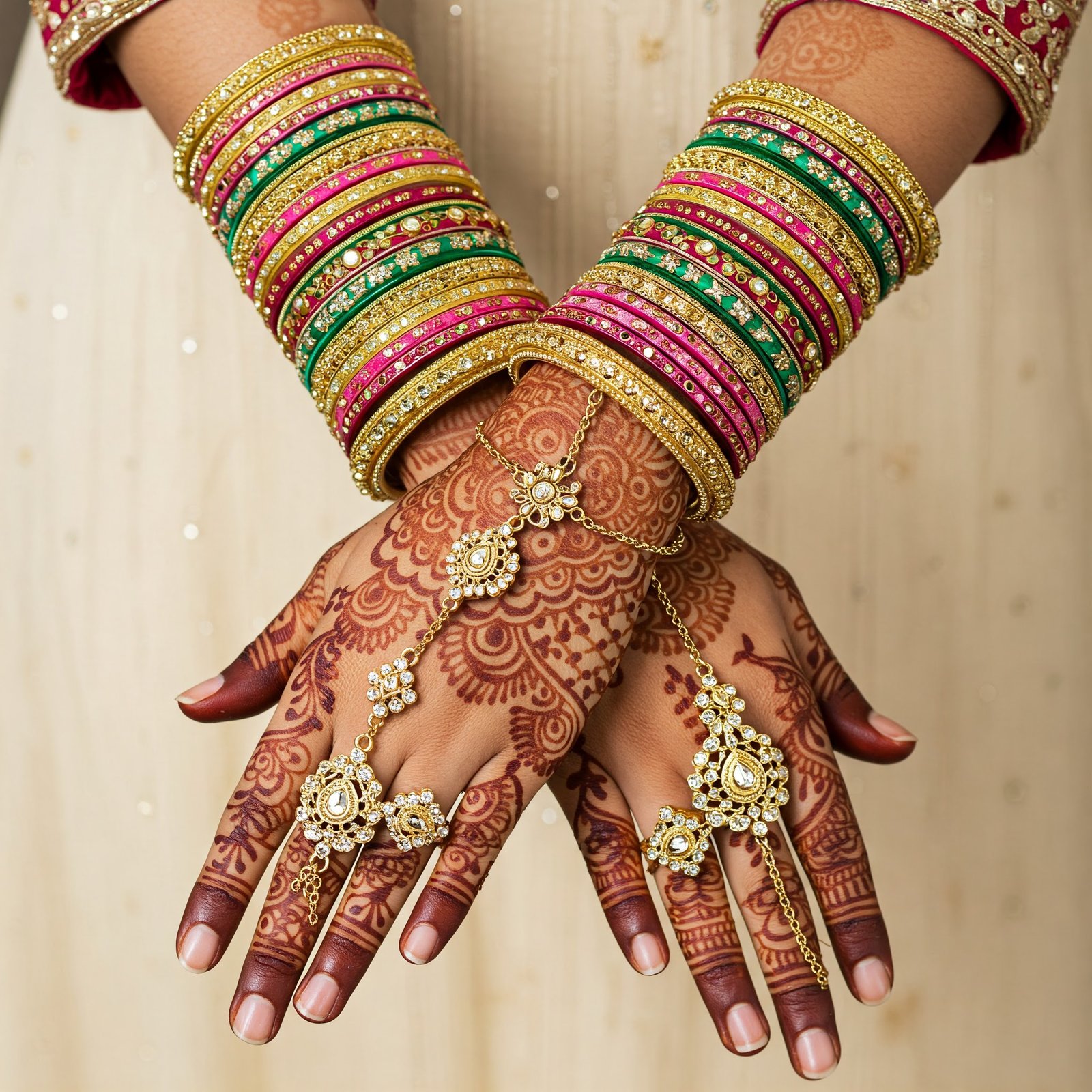
1. Traditional Bangles: From Kadas to Chooras
The sound of bangles has been the soundtrack to festive celebrations across cultures for centuries. From solid gold kadas (rigid bangles) to delicate glass chorus (bangle sets), these wrist adornments combine cultural significance with decorative appeal.
My personal collection includes a pair of gold-toned kadas passed down from my grandmother, colourful lac bangles purchased during travels in Rajasthan, and a special silver-plated set I wear specifically during Karwa Chauth. Each carries memories of specific celebrations and complements different festive ensembles.
What makes traditional bangles essential for festive occasions:
- The musical tinkling sound creates a festive ambience with every movement
- The circular shape symbolizes continuity and wholeness in many cultures
- The variety of materials and styles allows for personalized styling
- The stacking potential creates dimension and visual interest
My personal tip: For comfortable all-day wear during lengthy festivities, I alternate hard and soft bangle materials. For example, I might place fabric-backed lac bangles between metal pieces to prevent pinching or use bangle spacers to prevent friction and noise when movement is inappropriate.
2. Statement Cuffs and Bracelets
For those who find traditional bangle stacks cumbersome or too elaborate, statement cuffs offer a sophisticated alternative that still honours ethnic design traditions. A well-crafted cuff featuring traditional metalwork, stonework, or cultural motifs makes a powerful style statement with minimal effort.
I’ve found my gold-plated filigree cuff with ruby accents to be perfect for festive dinners and evening celebrations where I need free movement for greeting, eating, and participating in rituals. It provides the formal finish of traditional bangles with contemporary convenience.
What to look for in a festive statement cuff:
- Comfortable fit with a slight gap for easy removal
- Secure construction that won’t catch on delicate fabrics
- Balanced weight that stays in place without constant adjustment
- Cultural design elements that complement other jewellery pieces
My personal tip: Cuffs work particularly well for professional women transitioning from work to festive evening events. I keep mine in my desk drawer during busy celebration seasons, ready to instantly elevate my look before heading to after-work festivities.
3. Hathphool and Hand Harnesses
For truly special celebrations, hand harnesses (hathphool) offer a dramatic and photogenic jewellery option. These ornate pieces typically connect a bracelet to rings via decorative chains, adorning the back of the hand with intricate patterns.
I invested in a silver-toned hathphool for my sister’s wedding and was amazed by how this single accessory elevated my relatively simple outfit. The delicate chains caught the light with every gesture, creating magical photo moments throughout the celebration.
Why hand harnesses make unforgettable festive accessories:
- They draw attention to hand gestures, particularly beautiful during ceremonial moments
- They incorporate traditional craftsmanship in a distinctive, attention-grabbing way
- They create striking visual interest in photographs
- They make even simple outfits look exceptionally special
My personal tip: If you’re new to hand harnesses, choose an adjustable design for your first piece. I initially made the mistake of purchasing a fixed-size hath school that was uncomfortable by the end of the evening. Adjustable connections between the bracelet and rings allow for better movement and comfort.
-
“My friend’s viral reel featured this [stackable brass kada]—she got 12 DMs asking where it’s from.”
4- Cultural Heritage Pieces with Modern Appeal
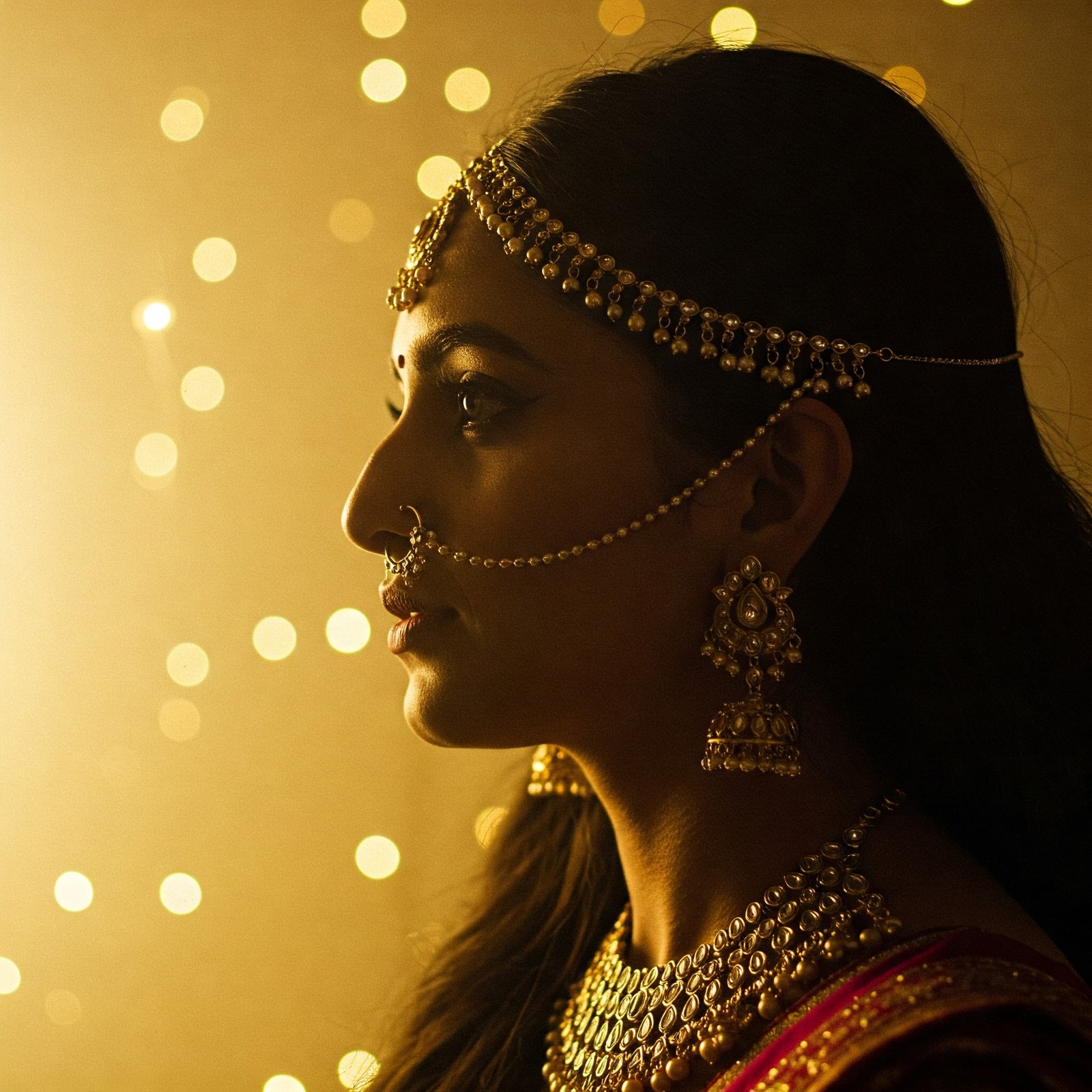
1. Maang Tikkas and Head Jewelry
Head ornaments hold special significance in many cultural traditions, and contemporary designs have made these pieces more wearable than ever. From elaborate maang tikkas (forehead ornaments) to subtle hair chains, these accessories frame the face beautifully while honouring traditional adornment practices.
I was initially hesitant about wearing head jewellery, worrying it might feel costumey or excessive. However, after finding a delicate gold-toned piece with a single droplet design, I discovered how this simple addition created a regal quality that transformed my entire festive look.
What makes head jewellery special for celebrations:
- The positioning naturally draws attention to the face and eyes
- The unexpected placement creates a memorable style statement
- The cultural significance connects to traditional beauty practices
- The photogenic quality captures attention in celebration memories
My personal tip: If you’re new to head ornaments, start with a simpler, lightweight design positioned at the side part rather than the centre parted. I found this placement more comfortable for extended wear and less dramatic for festive celebrations, where I didn’t want to appear overly formal.
2. Nose Rings and Naths
Across many cultures, nose ornaments carry deep traditional significance while simultaneously making a striking fashion statement. From delicate diamond studs to elaborate maths (nose rings with chains connecting to the ear), these adornments have experienced a significant revival in contemporary ethnic jewellery.
I incorporate a simple gold nose stud into my festive look that pays homage to my heritage without requiring the commitment of a permanent piercing (mine is clip-on). For close family ceremonies, I occasionally wear my mother’s delicate chain nath, which always elicits appreciative nods from the older generation.
The appeal of nose ornaments for festive wear:
- They create a traditional look instantly, even with modern outfits
- They frame the face from a different angle than conventional jewellery
- They connect to cultural beauty traditions across generations
- They offer options from subtle to statement, depending on personal preference
My tip: If you’re interested in nose ornaments but don’t have a piercing, look for high-quality clip or press-on options designed specifically for South Asian wear. These are typically more secure and comfortable than fashion clips and are designed to withstand the rigours of celebration.
3. Waistbands and Kamarbands
Waist jewellery (kamarbands) adds a regal touch to festive attire while creating a beautifully defined silhouette. These pieces range from elaborate gold-toned belts with dangling elements to subtle chains that add just a hint of adornment.
I discovered the transformative power of waist jewellery when trying to style an heirloom saree that felt somewhat plain compared to more contemporary designs. Adding a slim gold-plated kamarband instantly elevated the entire look, adding both visual interest and a touch of tradition.
Why waist ornaments make exceptional festive accessories:
- They define the waistline beautifully with traditional attire
- They add movement and sound with dangling elements
- They incorporate traditional craftsmanship in a structural way
- They create a complete, head-to-toe adorned look for special celebrations
My personal tip: For comfortable wear, I line the inside of metal kamarbands with thin velvet ribbon attached with double-sided clothing tape. This prevents the metal from digging in during long ceremonies and protects delicate fabrics from potential snags.
5 – Investing in Festival-Worthy Ethnic Jewelry
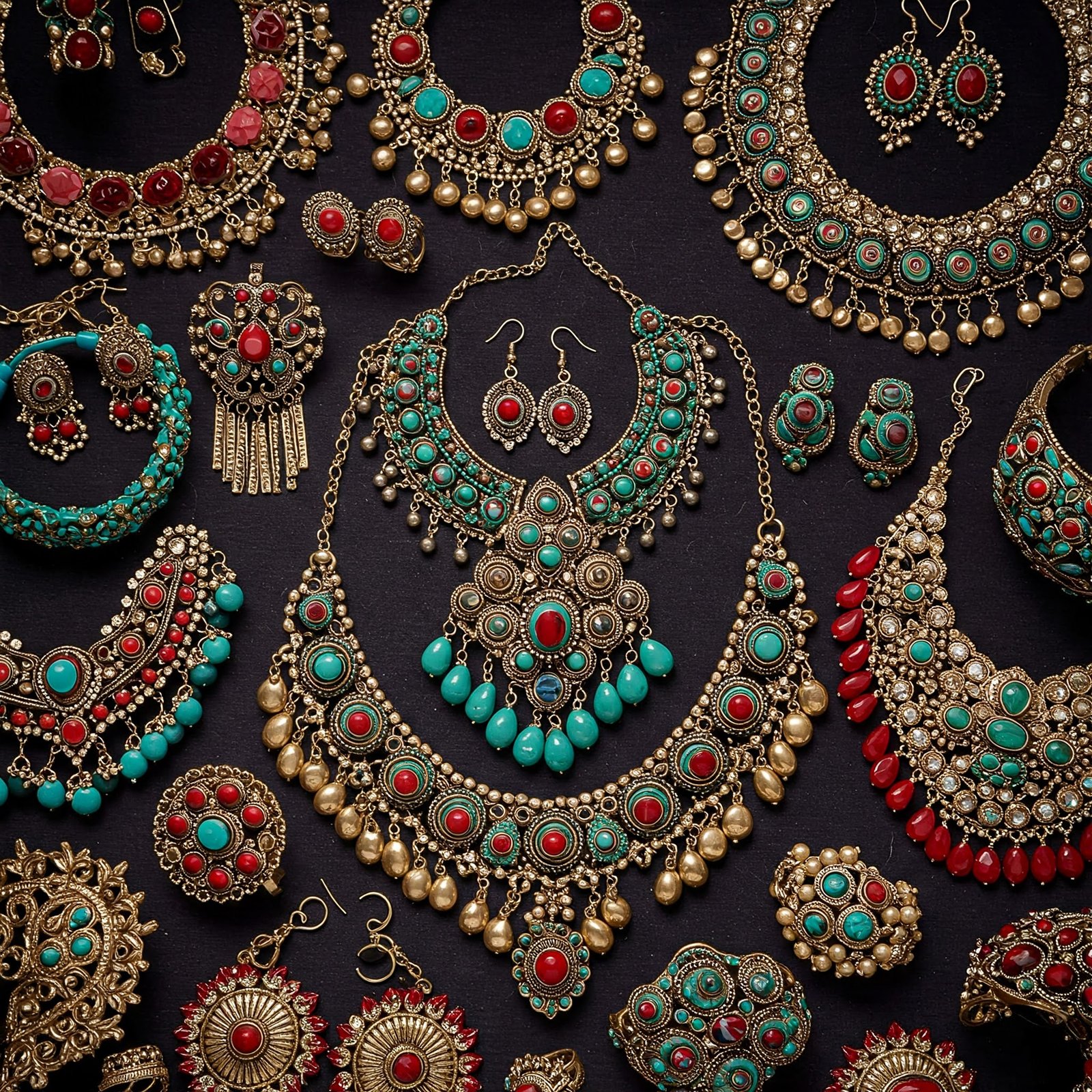
-
Understanding Quality and Craftsmanship
Throughout my jewellery collection journey, I’ve learned to identify quality craftsmanship that justifies the investment. When examining ethnic jewellery, I pay particular attention to the following:
- Finishing details: Check how clasps, back portions, and undersides are finished—quality pieces show attention to even unseen areas
- Stone Security: Gently run a fingernail across set stones to ensure they’re firmly secured
- Weight distribution: Well-designed pieces balance weight to remain comfortable during wear
- Material quality: Look for substantial plating, minimal tarnishing risk, and quality gemstones
- Craftsmanship signatures: Learn to recognise the hallmarks of different traditional techniques
I once passed on purchasing a dramatically discounted Kundan set after noticing uneven stone setting and poor enamel work—signs that the piece would likely deteriorate quickly and potentially lose stones during wear.
My tip: Develop relationships with reputable jewellers who specialize in ethnic designs. The guidance of an experienced jeweller has helped me make better investments and avoid costly mistakes when building my collection.
6 – Budgeting Across Different Jewelry Categories
Building a festival-worthy jewellery collection doesn’t require unlimited funds, just strategic investment across different price points:
- Investment pieces (higher budget): I allocate more resources to versatile necklaces and bangles that I’ll wear repeatedly across multiple celebrations and that incorporate precious or semi-precious materials.
- Mid-range staples: Statement earrings, bracelets, and smaller necklaces in gold-plated silver or high-quality brass allow for variety without major expense.
- Affordable accents: I refresh my collection seasonally with trendy pieces like binding rings, simple anklets, or contemporary nose pins at accessible price points.
My personal tip: I follow the 70/20/10 rule for my ethnic jewellery budget: 70% toward investment pieces that will last decades, 20% toward mid-range items that offer versatility for 3-5 years, and 10% toward trendy seasonal pieces that keep my collection feeling fresh.
7 – Caring for Your Ethnic Jewelry Collection
The most beautiful ethnic jewellery can lose its lustre without proper care. My maintenance routine includes:
- Individual storage: I keep pieces in separate cloth pouches or compartments to prevent tangling and scratching
- Humidity control: Silica gel packets in my jewellery box protect against moisture damage, which is particularly important for pieces with Kundan work
- Regular cleaning: I gently clean my pieces with appropriate methods based on materials—soft cloths for polished surfaces, soft brushes for intricate details
- Professional maintenance: I have my heirloom pieces and significant investments checked annually by a jeweller for loose stones or weakened clasps
My personal tip: I maintain a simple inventory of my valuable pieces with photos and purchase information. This serves both as insurance documentation and as a reference when planning outfits for upcoming celebrations.
8 – Styling Ethnic Jewelry for Maximum Impact
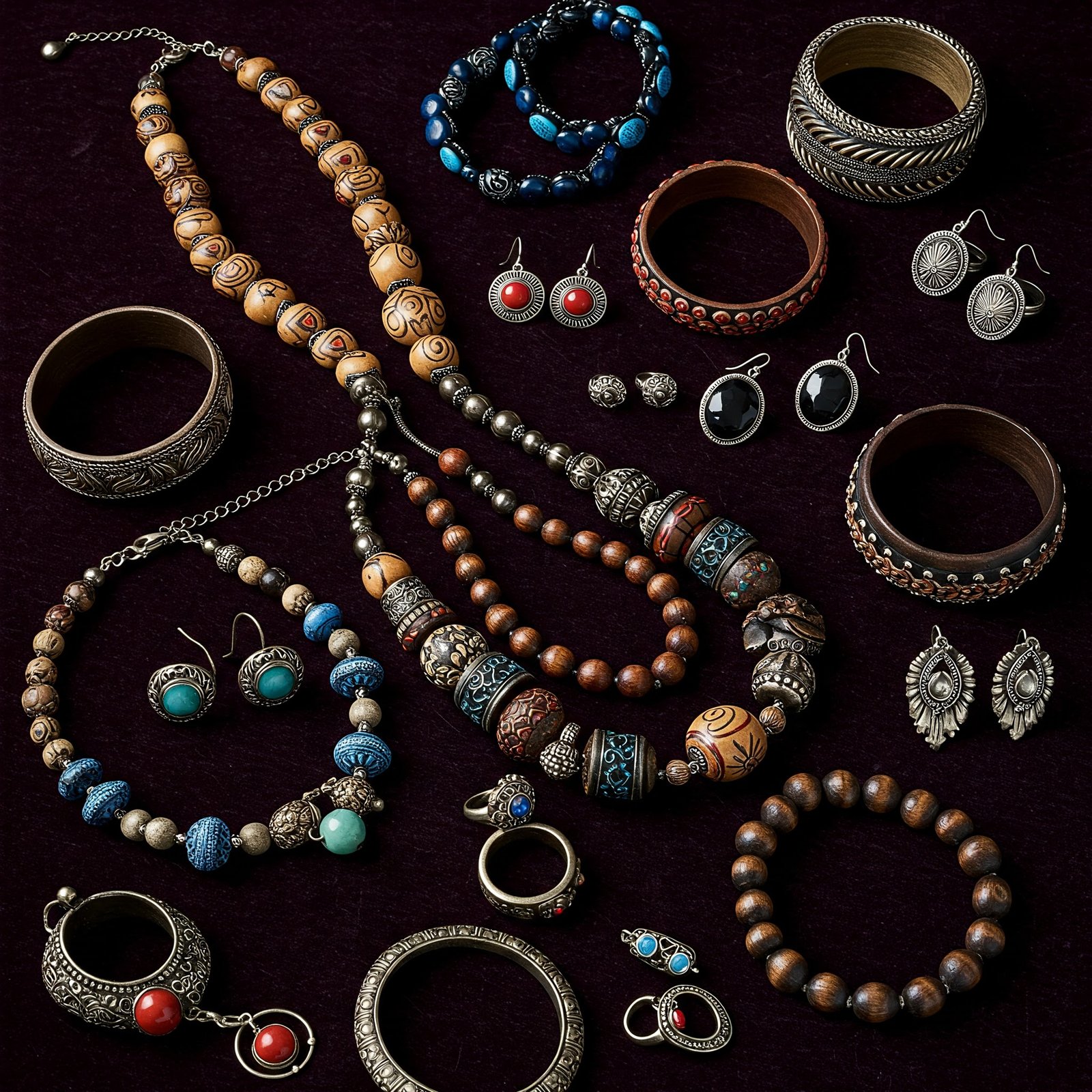
-
Balancing Jewelry with Outfits
The art of wearing ethnic jewellery beautifully involves creating harmony between your adornments and attire:
- With heavily embroidered or embellished outfits: I choose one statement piece (usually earrings or a necklace) and keep other jewellery minimal to avoid competition.
- With simpler traditional attire: This is where I layer multiple complementary pieces for a regal effect.
- With fusion or contemporary outfits, I select pieces that reference tradition while complementing modern silhouettes.
I once made the mistake of wearing an elaborate Kundan set with a heavily embroidered silk saree for a family wedding. The combination felt overwhelming, and in photographs, the beautiful details of both the jewellery and the saree were lost in the visual chaos.
My personal tip: Take a photo of your complete look before leaving for a celebration. The camera often reveals balance issues that aren’t obvious in the mirror, giving you a chance to adjust your jewellery selection.
9 – Creating Harmonious Jewelry Combinations
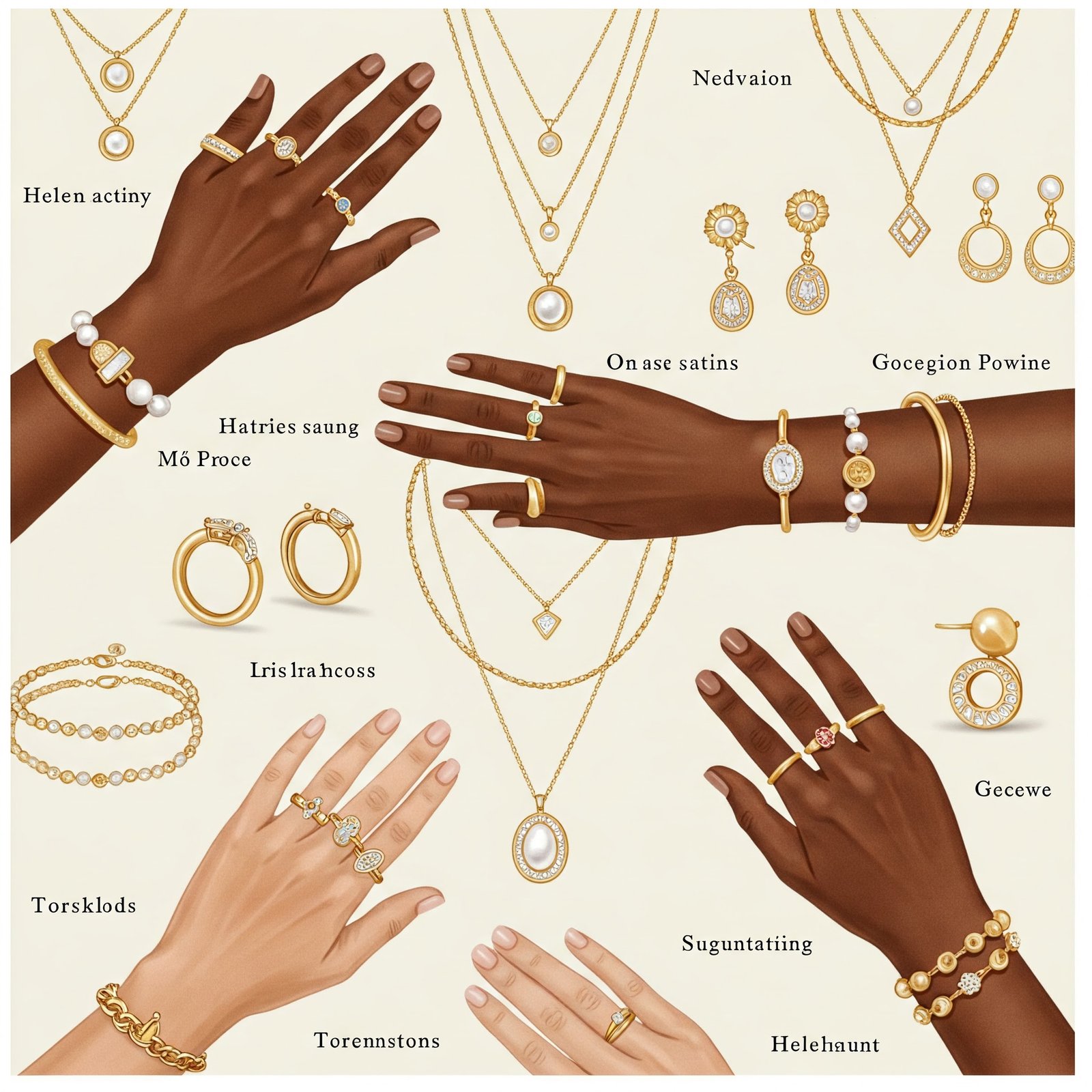
Mixing different ethnic jewellery pieces requires understanding how they interact:
- Metals: I either commit to one metal tone throughout or deliberately mix metals with a connecting piece that incorporates both
- Design languages: I ensure all pieces speak the same design “language”—all temple-inspired, all Kundan, or all tribal, for example
- Weight and proportion: I balance heavier pieces with lighter complimentary items
- Cultural references: When borrowing from different cultural traditions, I’m careful to create respectful combinations
My personal tip: When wearing multiple statement pieces, I ensure they have physical space between them. For example, if wearing a maang tikka and statement earrings, I’ll style my hair to create separation between these focal points.
10 – Choosing Jewelry for Specific Festive Occasions
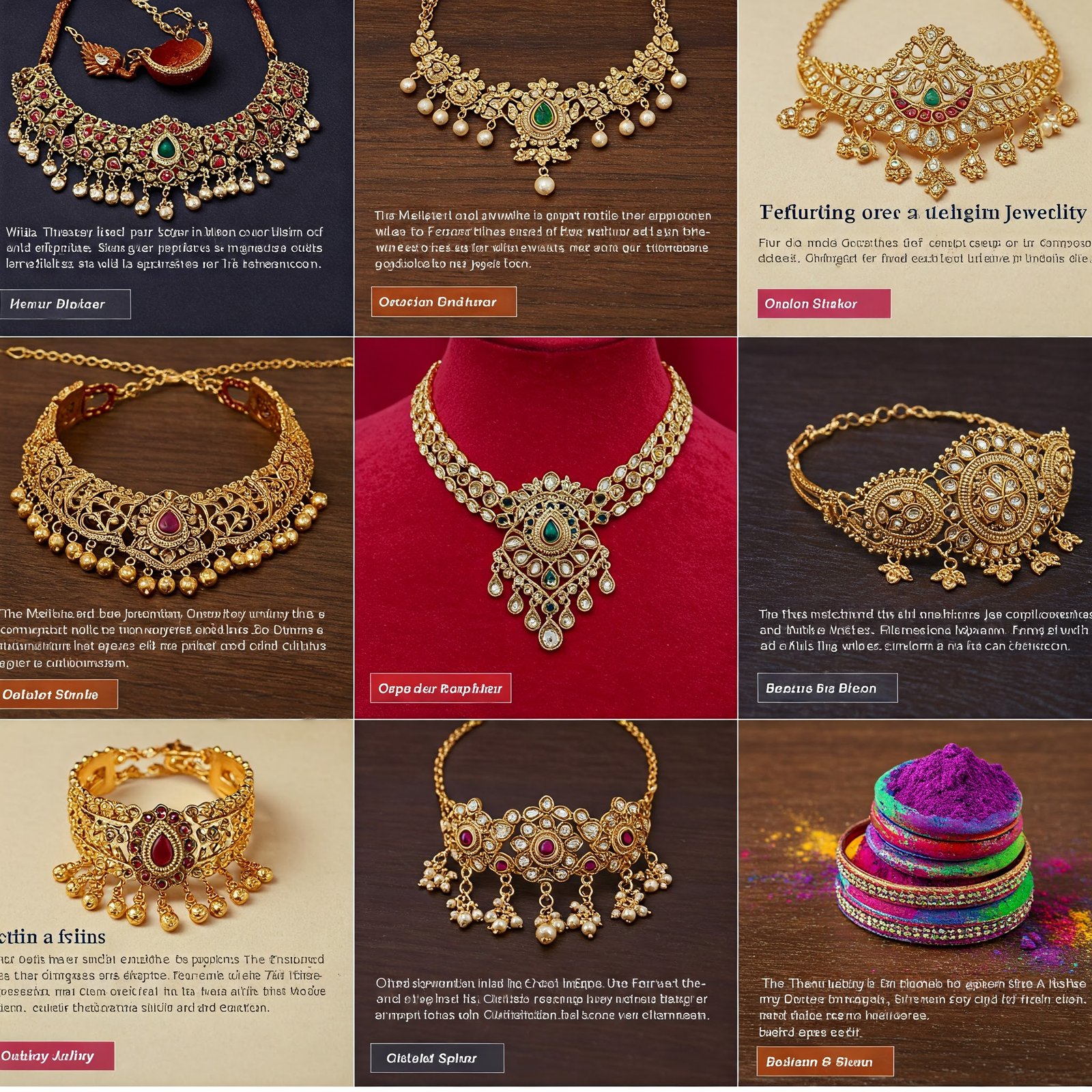
Different celebrations call for different jewellery approaches:
- Religious ceremonies: I lean toward traditional pieces with cultural significance and more conservative styling
- Wedding celebrations: This is where my most elaborate sets shine, carefully coordinated with formal attire
- Family gatherings: I opt for meaningful heirloom pieces that spark connection and conversation
- Community festivals: Practical yet beautiful pieces that allow for movement and participation in activities
My personal tip: Consider the practical aspects of each event when selecting jewellery. For active celebrations with dancing and games, I choose more secure pieces that won’t catch on fabrics or become uncomfortable during movement.
FAQs
How can I incorporate ethnic jewellery into Western outfits to fuse festive looks?
My favourite approach is selecting one statement ethnic piece as a focal point with an otherwise Western outfit. A handball earring paired with a simple black dress, a traditional kamarband over a flowing maxi, or a statement cuff with a tailored jumpsuit creates beautiful cultural fusion. The key is allowing the ethnic piece to stand as the star against a simpler background rather than competing with other strong elements.
What ethnic jewellery pieces work best for someone just starting their collection?
I recommend beginning with versatile earrings—either jhumkas or chandbalis in a size you find comfortable. These instantly create a festive look even with simple outfits and require less investment than elaborate necklace sets. Next, add a statement bracelet or cuff that works across different outfits. These two pieces will serve numerous celebrations while you gradually build toward more significant investments like necklaces.
How can I wear family heirloom pieces without looking outdated?
I modernize heirloom jewellery by pairing it with contemporary outfits—traditional jhumkas with a modern silhouette, for example. Another approach is wearing just one vintage piece as a focal point rather than the complete traditional set. If the piece itself feels too dated, consult with a jeweller who specializes in ethnic designs about respectfully reimagining elements into a new piece that honours the original while suiting contemporary aesthetics.
Ethnic jewellery does much more than complete a festive outfit—it connects us to cultural heritage, supports traditional craftsmanship, and often becomes part of our own family story. As you prepare for the upcoming celebration season, I hope these suggestions help you discover pieces that bring both beauty and meaning to your festive moments.
What’s your most treasured ethnic jewellery piece? Share your story in the comments below!
